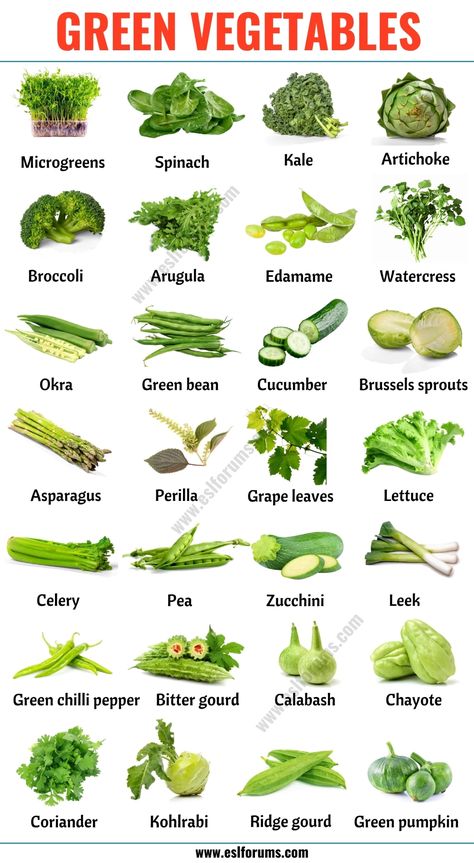Green vegetables for baby food
Adding Greens to Your Baby's Diet
How to introduce green vegetables to your baby may be a question on your mind if you have a new eater. Here are some of the benefits of greens for babies and how to incorporate them.
It’s no secret that green vegetables offer tons of health benefits at any age.
While there are some considerations with how to introduce them to young babies, greens are a great way to incorporate vitamins, minerals, and phytochemicals into your child’s diet.
Health Benefits of Green Vegetables
Green vegetables offer a number of benefits for all of us, especially for developing minds and bodies.
Dark leafy greens, like Swiss chard, collard and mustard greens, kale, spinach, and broccoli, are rich in:
- Folate, a B vitamin needed for energy, RNA, and DNA production, making red and white blood cells, supporting brain health, and preventing neural tube defects in newborns.
- Vitamin K, which plays an integral role in bone health and blood clotting, and regulating blood calcium levels.
- Vitamin C, necessary for producing collagen, wound healing, promoting iron absorption, supporting immune function, and repairing tissues.
- Calcium, needed for bone health, as well as proper muscle, nerve, and heart function.
- Vitamin A, important for growth, development, vision protection, and immune function.
Research shows that diets rich in leafy greens and cruciferous vegetables (like broccoli) have been associated with a lower risk for heart disease and certain cancers, and may even slow cognitive decline with aging.
Introducing your child to green veggies early in life can help him or her become more accustomed to these foods, and even develop an affinity for them as they get older.
How to Introduce Greens to Babies
The most important thing to remember when introducing first foods is that they should be offered in an age appropriate texture and consistency.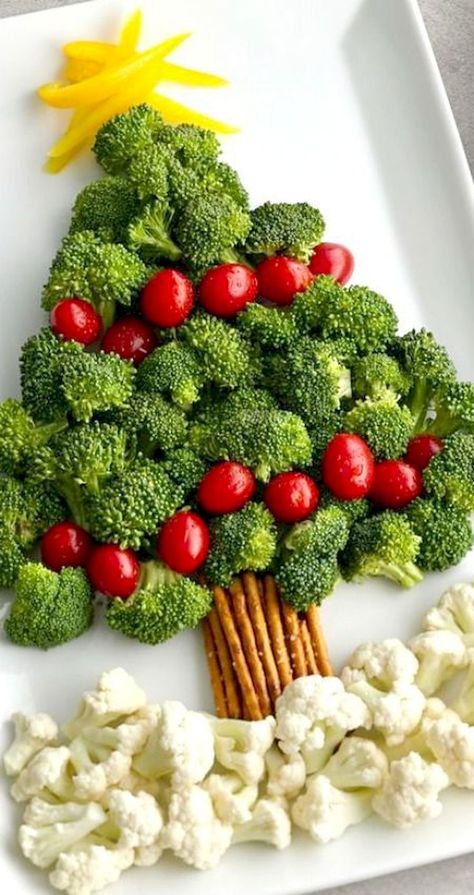 Raw uncooked greens, especially the leafy ones, can be a choking hazard and should be avoided for new eaters.
Raw uncooked greens, especially the leafy ones, can be a choking hazard and should be avoided for new eaters.
Still, green veggies like broccoli, spinach, kale, collard greens, Swiss chard, green beans, and peas, can be cooked and pureed to make sure they’re safe for younger kids to eat.
Steaming and boiling these foods can work well to soften them before pureeing or blending them. We recommend then using a strainer to remove any large chunks from cooked and pureed greens before offering them to babies.
Prepared green veggies can be mixed with other foods to add more flavor and nutrients at meal times.
For instance, they can be mixed with avocado, mashed potatoes, or cooked grains like quinoa or rice. Your baby may also like strips of toast spread with hummus and pureed, strained greens.
We also like using cooked greens in fruity breast milk popsicles for new eaters. It’s a great way to introduce bitter greens! You can find the recipe in our Ebook, First Bites: The Definitive Guide to Baby-Led Weaning for Plant-Based Babies.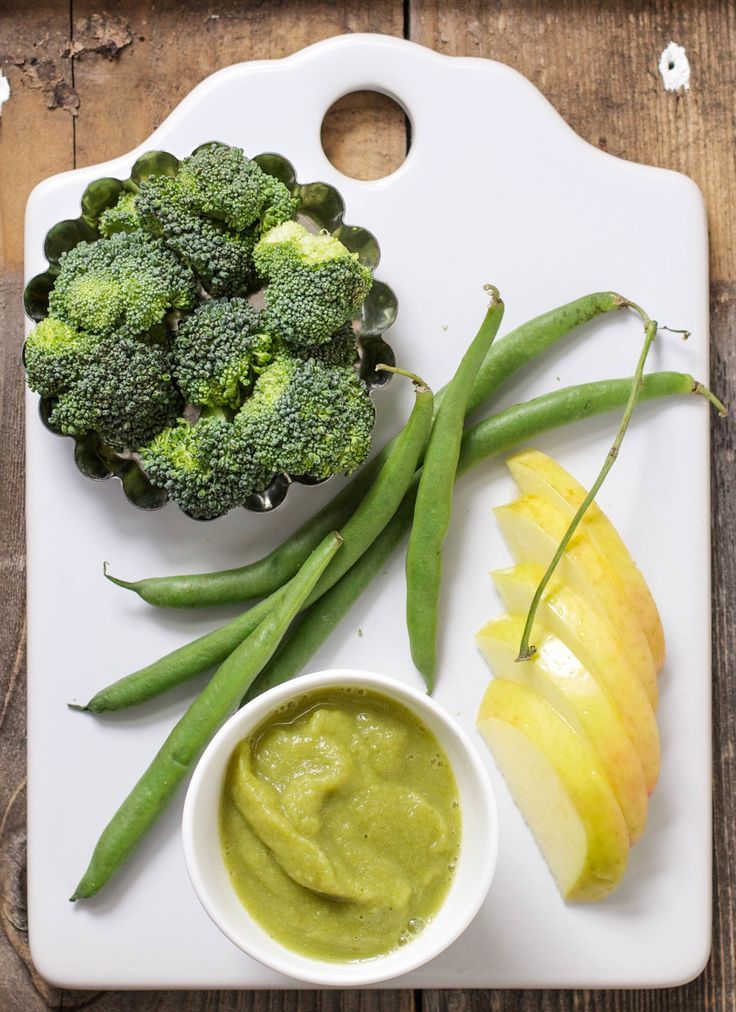
Recipes Using Green Vegetables
As your child learns to enjoy green veggies, you can start becoming more creative with the ways you expose them.
Here are some of our favorite recipes incorporating healthy green veggies that the whole family can enjoy together:
- Healthy Creamed Spinach
- Vegan Spinach Lasagna with Cashew Ricotta
- Baby Led Weaning Muffins
- Vegan Sweet Potato Mac and Cheese with Broccoli
- Anti-Inflammatory Green Smoothie
If you’re wondering how to introduce green vegetables to your baby, and the benefits of greens for babies, we hope that some of these tips and ideas will help!
Chime In: Does your family enjoy green veggies? What is your favorite way to to prepare them?
If you enjoyed this article, check out some of our others:
- Benefits of Beans for Babies
- How to Feed Tofu to Kids
- When Can Babies Have Nuts?
- How Do I Introduce My Baby to Allergenic Foods?
Vegetable Puree for Baby: Broccoli, Spinach, Cauliflower
By Anjali Shah on · Last Updated on
This post may contain affiliate links.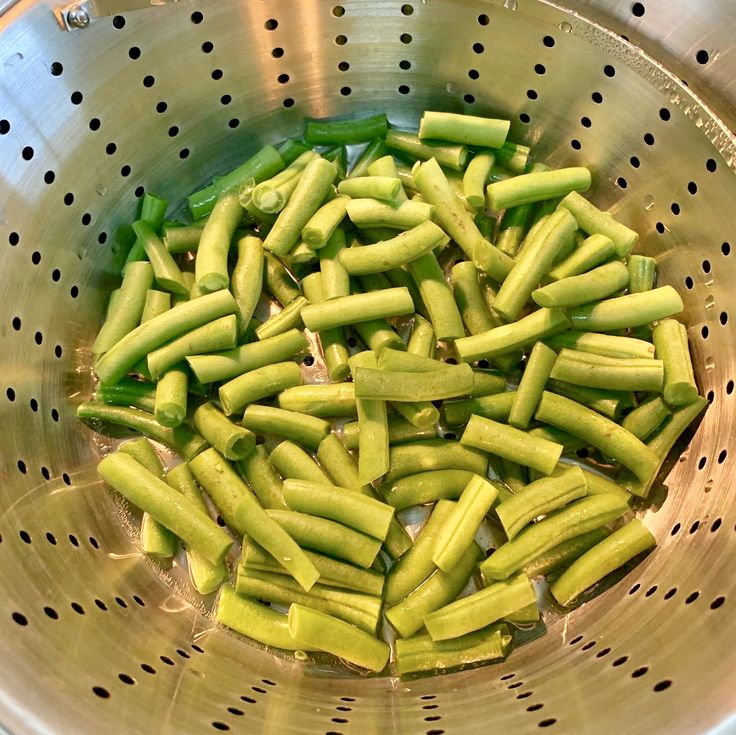 As an Amazon Associate, I earn from qualifying purchases. Please read my disclosure.
As an Amazon Associate, I earn from qualifying purchases. Please read my disclosure.
A nutrient rich vegetable puree for baby with three of the healthiest green vegetables. Broccoli, cauliflower, and spinach have tons of health benefits and essential nutrients for young babies. This green vegetable puree has a mild flavor baby will love! Make sure your baby gets their veggies by introducing this puree into their daily repertoire!
Get your greens! This vegetable puree for baby is one of the most nutritionally dense purees out there. It combines two of my favorite superfoods and cruciferous veggies: cauliflower and broccoli; with one of the healthiest green veggies out there: spinach! When you’re starting out on solid foods, this is a great way to make sure your baby gets their greens daily in a simple, homemade baby food puree recipe.
Latest Recipe Video!
All three veggies contain phytonutrients, which have significant anti-cancer effects.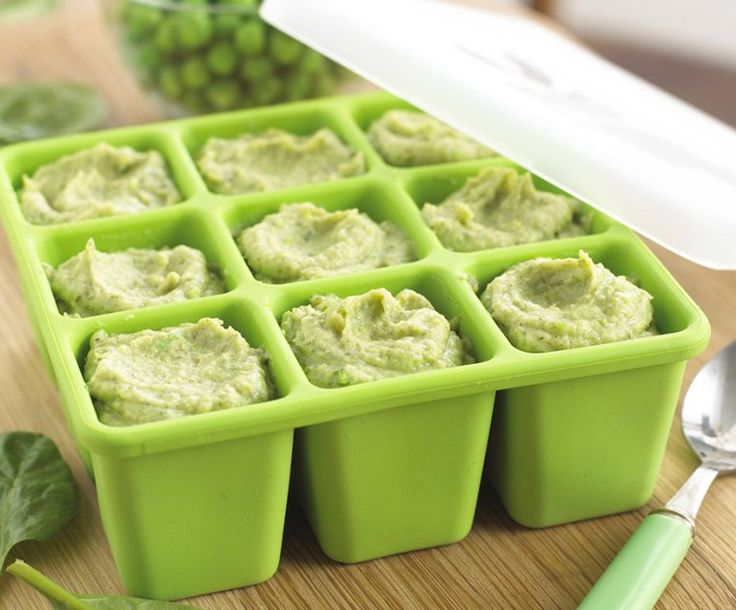 They are all rich in vitamins, minerals and fiber too, and spinach is a veggie friendly source of iron.
They are all rich in vitamins, minerals and fiber too, and spinach is a veggie friendly source of iron.
I typically recommend introducing this recipe after a food like avocados or green beans, which are mild and make a great first food for babies. Because these greens have a stronger flavor, it’s best to introduce this recipe in small amounts after your baby has already had a few different types of food and a few basic purees.
Why This Recipe Works
- Stage 1 Baby Food
- Three nutrient rich vegetables in one puree
- Simple 3 ingredient recipe plus water
- Easy and quick to prepare
- Budget-Friendly
- Healthy for baby’s diet
- Makes a large batch
- Keeps in the freezer for 4 months
How to Make Vegetable Puree for Baby
Recipe Ingredients and Notes
Organic Broccoli: Use frozen or fresh organic broccoli florets. Using organic produce helps to reduce pesticide exposure for your baby. Broccoli is rich in fiber, iron, calcium, antioxidants, folate, potassium, vitamins A, C and K, all of which are important for your baby’s growth and development.
Broccoli is rich in fiber, iron, calcium, antioxidants, folate, potassium, vitamins A, C and K, all of which are important for your baby’s growth and development.
Organic Cauliflower: Use fresh or frozen organic cauliflower florets. Cauliflower is high vitamin C which helps to support the immune system.
Organic Spinach: Use fresh or frozen leaf spinach. Leafy greens contain numerous essential vitamins and minerals. It is rich in fiber, omega-3 fatty acids, and protein.
Equipment Needed
- Steamer basket or a large pot.
- A high-speed blender or food processor to puree the sweet potato. You don’t need a baby food maker!
- Mumi & Bubi Trays for storing
Step by Step Instructions
Prepare and steam vegetables: Put all of the frozen veggies in your steamer and steam for 5 minutes until the broccoli and spinach is bright green.
Puree and Store: Put into a blender in batches (there will be too much to put in all at once) and blend until it has a smooth consistency. Add water to thin the puree as needed. Pour into ice cube trays, allow to cool, cover or wrap with plastic wrap, and freeze.
Add water to thin the puree as needed. Pour into ice cube trays, allow to cool, cover or wrap with plastic wrap, and freeze.
Thaw and Serve: Thaw in the fridge the night before use, or thaw by putting the ice cube in a bowl over a bowl of hot water on the counter to defrost.
Recipe FAQs
What makes broccoli, cauliflower, and spinach healthy for baby?
The combination of broccoli, cauliflower, and spinach provides a rich source of vitamins and minerals for your baby. It’s high in fiber to help with constipation and digestion. Additionally, broccoli, spinach, and cauliflower are sources of vitamin C that help support baby’s immune system. Spinach also contains Omega-3 fatty acids, and protein that helps with brain development.
What vegetables can I puree for baby?
Some of the best vegetables to puree for your baby include broccoli, cauliflower, spinach, carrots, kale, green beans, peas, sweet potato, butternut squash, and zucchini.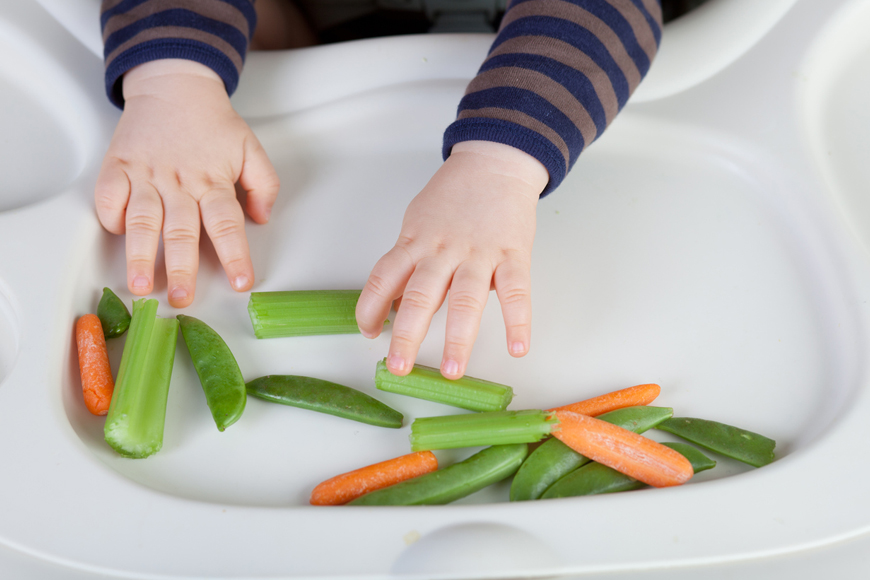 These vegetables are mild in flavor, and rich in vitamins and nutrients. They are simple to puree.
These vegetables are mild in flavor, and rich in vitamins and nutrients. They are simple to puree.
Can you boil vegetables for baby food?
Yes, you can boil vegetables and then puree them to create baby food. If you boil veggies for baby food purees, I recommend pureeing the veggies with the water you boiled them in – to ensure you retain any nutrients that seeped into the water during the boiling process. You can also steam or roast vegetables and use them to puree.
How do you store and keep vegetable puree?
Store the vegetable puree in ice cube trays, or transfer the frozen puree cubes to freezer safe zip-top bag. It will keep for 4 months in the freezer. Be sure to label with the date and contents. This puree will keep in the refrigerator for 3-4 days. When ready to use a frozen cube, place cubes in an airtight container in the refrigerator to defrost overnight. Serve at room temperature.
Variations and Substitutions
Add Fresh Herbs: Bring a fresh earthy flavor to this recipe be adding fresh leafy green herbs such as cilantro, mint, parsley, or basil.
Add Spices: Spice up your baby’s food! Serve with a pinch of garlic powder, onion powder, cumin, coriander, or mild curry powder.
Boil Vegetables: Place all of the vegetables in boiling water. Boil until vegetables turn bright green and are soft when pierced with a fork. Drain the water. Place in a blender and add fresh filtered water. Puree until smooth.
Roast Cauliflower and Broccoli: Instead of using frozen produce, you can use fresh broccoli and cauliflower. Place the florets on a parchment lined baking sheet. Roast for 20-25 minutes at 425 F. Then blend with water and spinach. Roasting the vegetables will give them a deeper flavor.
Try a Different Combination of Vegetables: You can add just about any vegetable purees into this mix of cruciferous veggies! Any fresh vegetables turned into a puree would work: Sweet potato puree, green peas puree, carrot puree, pumpkin puree, beetroot puree or any roasted root vegetables (pureed) would taste great!
Add Breast Milk or Formula: Feel free to add breastmilk or organic baby formula right before serving to thin out this puree a bit more.
Add Protein: For babies over 8 months of age, you can combine this puree with a red lentils puree for added protein. For even older children and once you have checked for nut allergies, you can combine this with peanut butter or any nut butter too!
Expert Tips for Making Vegetable Puree for Babies
- There is a ton of fiber in this puree, so there is the potential for gas and/or tummy troubles if you introduce too much of it at once. As with any new food, introduce it slowly, early in the day so any after-effects or any allergic reaction is dealt with before bedtime.
- This puree does not have a sweet flavor. If your baby rejects it outright, try mixing it with a baby puree that’s a bit sweeter like banana puree, pear puree, or any simple fruit purees with non-acidic fresh fruit (apples, ripe avocados, etc). You can also try mixing it with whole milk organic yogurt and a little bit of a different fruit puree.
More Baby Food Recipes and Tips!
- Green Bean Puree
- Sweet Potatoes Baby Food
- Zucchini and Apple Puree
- Butternut Squash Puree
- Pea Puree
- Superfoods for Babies and Recipe Ideas
- 10 Easy Baby Food Recipes for Beginners – Your Ultimate Guide to making baby food at home!
If you have tried this Vegetable Puree Recipe for your baby, or any other recipe on my blog, then please rate it and let me know how it turned out in the comments below! Then, FOLLOW ME on FACEBOOK, TWITTER, INSTAGRAM, and PINTEREST to see more delicious, healthy, family-friendly food!
Print Recipe5 from 5 votes
Vegetable Puree for Baby: Broccoli, Cauliflower, and Spinach
A nutrient rich vegetable puree for baby with three of the healthiest green vegetables.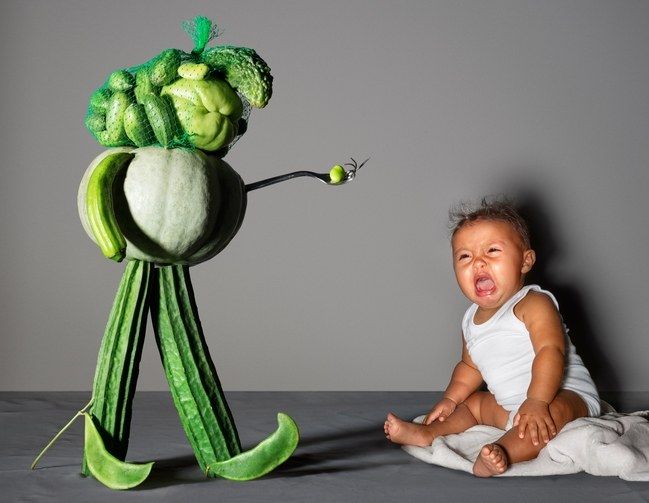 Broccoli, cauliflower, and spinach have tons of health benefits and essential nutrients for young babies. This green vegetable puree has a mild flavor baby will love! Make sure your baby gets their veggies by introducing this puree into their daily repertoire!
Broccoli, cauliflower, and spinach have tons of health benefits and essential nutrients for young babies. This green vegetable puree has a mild flavor baby will love! Make sure your baby gets their veggies by introducing this puree into their daily repertoire!
Prep Time5 mins
Cook Time15 mins
Total Time20 mins
Course: Baby Food
Cuisine: American
Servings: 100 tablespoons
Calories: 17.4kcal
Author: Anjali Shah
- ▢ 5 cups frozen organic broccoli
- ▢ 5 cups frozen organic spinach
- ▢ 10 cups frozen organic cauliflower
- ▢ At least 16oz water – more for a thinner puree
- ▢
Put all of the frozen veggies in your steamer and steam for 5 minutes until the broccoli and spinach is bright green.
- ▢
Put into a blender in batches (there will be too much to put in all at once). Add water to thin the puree.
- ▢
Pour into ice cube trays, allow to cool, cover/wrap and freeze.
- ▢
Thaw in the fridge the night before use, or thaw by putting the ice cube in a bowl over a bowl of hot water on the counter to defrost.

https://youtu.be/tnm30j13HzQVideo can’t be loaded because JavaScript is disabled: Broccoli, Spinach and Cauliflower Puree Video (https://youtu.be/tnm30j13HzQ)
Expert Tips
- There is a ton of fiber in this puree, so there is the potential for gas and/or tummy troubles if you introduce too much of it at once. As with any new food, introduce it slowly, early in the day so any after-effects or any allergic reaction is dealt with before bedtime.
- This puree does not have a sweet flavor. If your baby rejects it outright, try mixing it with a baby puree that’s a bit sweeter like banana puree, pear puree, or any simple fruit purees with non-acidic fresh fruit (apples, ripe avocados, etc). You can also try mixing it with whole milk organic yogurt and a little bit of a different fruit puree.
- This recipe makes 100 tablespoons of puree. One serving is about 4 tablespoons of vegetable puree.
- Spice up your baby’s food! Serve with a pinch of garlic powder, onion powder, cumin, coriander, or mild curry powder.
 You can also bring a fresh earthy flavor to this recipe be adding fresh leafy green herbs such as cilantro, mint, parsley, or basil.
You can also bring a fresh earthy flavor to this recipe be adding fresh leafy green herbs such as cilantro, mint, parsley, or basil.
Serving: 4tablespoons | Calories: 17.4kcal | Carbohydrates: 3.5g | Protein: 1.6g | Sodium: 22.5mg | Potassium: 204.6mg | Fiber: 2g | Sugar: 1g
First food. What do moms need to know? | BuyMama Vologda
When to start?
There is no single answer, there are only a few recommendations. Experts advise doing this from 5 to 8 months. You should not rush into this issue, because this can lead to adverse consequences, for example, an allergic reaction, constipation, colic, etc.
The type of feeding of the baby is of great importance. If he is on artificial feeding, then you can start complementary foods early - at 5-6 months, if he is breastfeeding, then definitely not earlier than 6 months, because until this moment the baby receives everything he needs from milk.
The second is the child's body weight.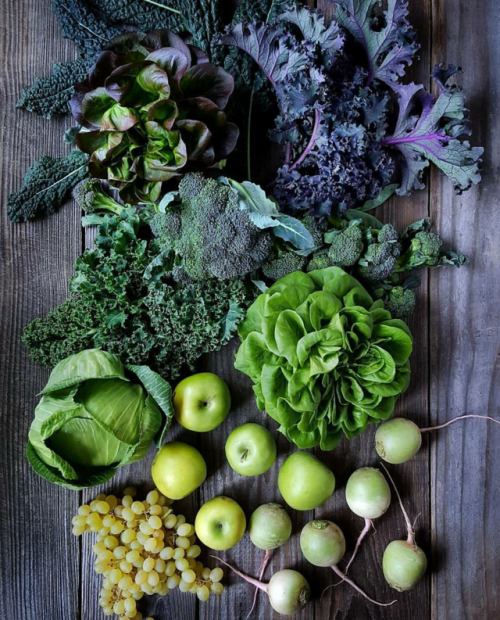 After birth, he must increase it at least twice.
After birth, he must increase it at least twice.
Also, the child should not have a repulsive tongue reflex when you offer him a spoon. It is desirable that the child already knew how to sit and showed interest in "adult" food. You may notice that your baby is no longer full of your milk or formula.
Principles for introducing complementary foods
- The most important rule is that you can only give your baby a new food when he is healthy and well.
- The first complementary food should be one-component, i.e. consist of one product. It is better that these are vegetables, green or white.
- Each product should be introduced gradually. For example, you chose cauliflower. On the first day, you give 5 g - that's about half a teaspoon. You need to give the product in the morning, so that during the day you can check the reaction of the baby. If everything went well, then the next day you can already give 10 g - a whole teaspoon.
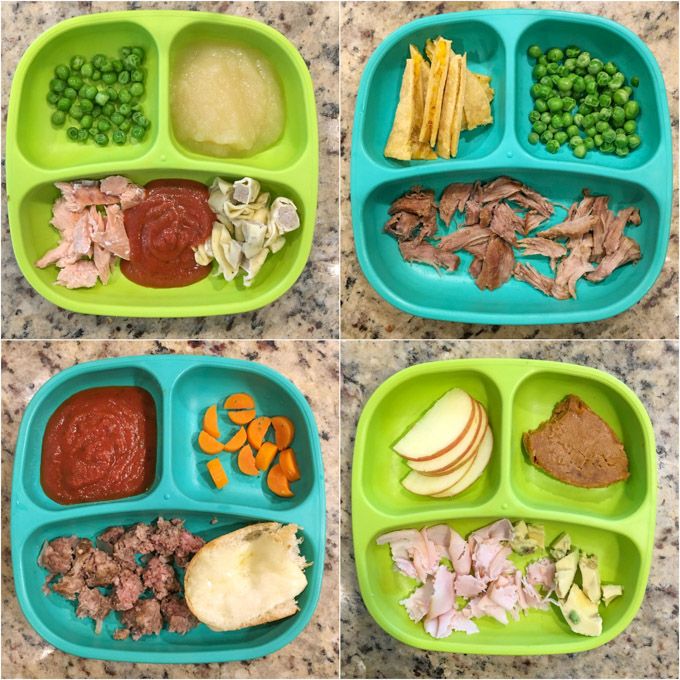 If all is well, then double the next day and so gradually increase the dose to 120 g.
If all is well, then double the next day and so gradually increase the dose to 120 g. - When you have entered one vegetable, you can enter the next one. For example, 5 g of squash puree + 115 g of cauliflower puree and gradually add a dose of squash puree if the baby's reaction is positive.
- Another important rule is that you offer your baby food exactly when he is hungry. You can feed him puree first, and if he is not full, then breastfeed or formula, but not vice versa.
First products
Experts advise choosing green or white vegetables for the first feeding: zucchini, cauliflower, broccoli.
Carrots and pumpkin can then be added.
After 7 months you can include porridge in your diet. Better if they are dairy-free and gluten-free. Suitable rice, buckwheat and corn. If the child refuses such porridge, then you can dilute it with your breast milk or infant formula.
After vegetables and cereals, you can introduce your child to fruits.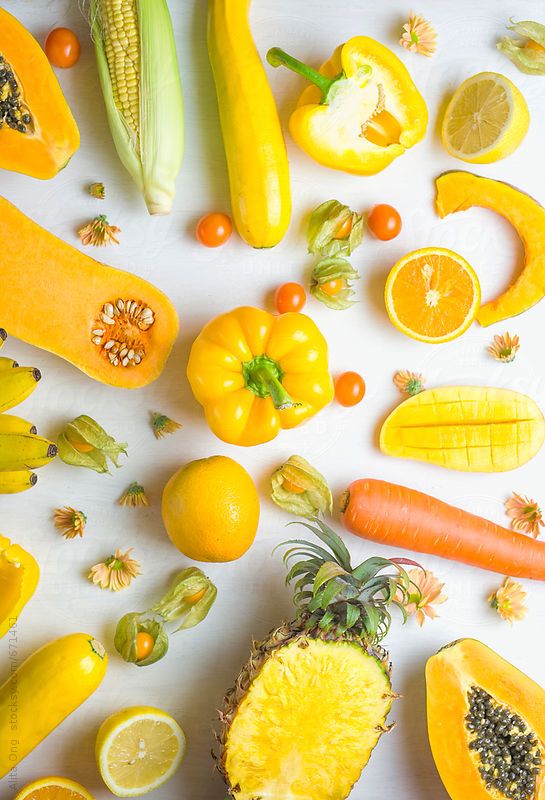
After 8 months you can slowly give meat: chicken, turkey, rabbit, beef. Also during this period, you can gradually give a taste of the yolk.
After 9 months, fermented milk products can be included: low-fat kefir and cottage cheese.
After 10 months fish can be added to the diet.
Place and utensils for the first feeding.
The baby must have its own place for feeding. It is best if it is a special chair. If your baby is a fidget, then it is better to immediately fasten it with straps.
Purchase a bib. There are special bibs with a lapel at the bottom, where the food that did not end up in the mouth will fall.
Cymbals must be unbreakable, lightweight. There are even special plates on the suction cup that can be fixed and the child will not turn it over on itself and will not spill anything.
Spoons for the first feeding should be soft, silicone. There are spoons that change color when in contact with high temperatures and she will tell you if the food is too hot.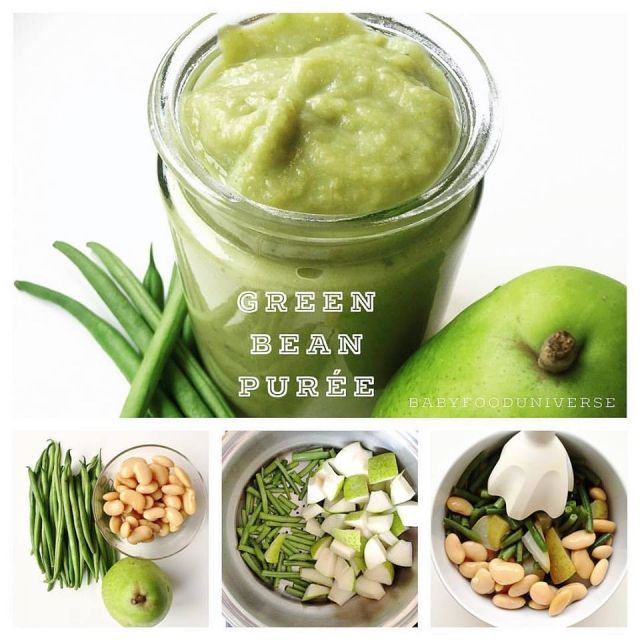
All recommendations in this article are for guidance only. A detailed consultation with a pediatrician will help you choose the first feeding regimen for your baby.
Feeding the baby with vegetables | Kukuzya.ru
Vegetables as the first complementary foods
Complementary foods with vegetables
From 4.5-5.5 months, more solid foods can be introduced into the child's diet than breast milk or an adapted milk formula, which is designated by the term "complementary foods". As the first complementary foods, it is preferable to prescribe vegetable puree. Vegetable puree is a source of organic acids, potassium, iron and dietary fiber, including pectins. Vegetable puree as the first complementary foods should be given to children with exudative-catarrhal diathesis, rickets, obesity, anemia, premature birth.
Complementary vegetable puree is a product obtained by mashing whole or peeled fresh or quick-frozen vegetables of one or more types, previously subjected to thermal processing (blanching).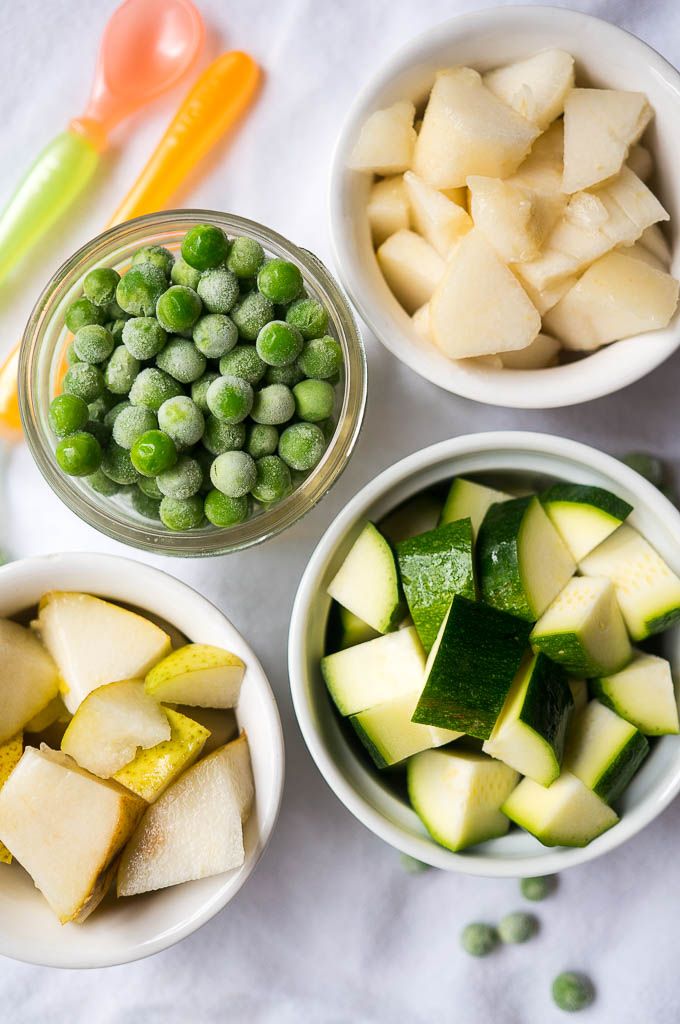
The introduction of vegetables as a second complementary food, after the introduction of cereals
The second complementary food in the form of vegetable puree from natural vegetables for baby food (without the addition of milk and without legumes) is introduced in parallel with the first, a month after the introduction of the first complementary foods and complete replacement of one feeding .
Which vegetables to start complementary foods with
The introduction of vegetable complementary foods should begin with one type of vegetable with delicate fiber and light color (from green or white vegetables), for example, zucchini or cauliflower , moving on to a mixture of vegetables , with a gradual expansion of the range using potatoes, pumpkins, carrots, later - tomatoes, green peas.
Vegetables for the first food
Zucchini, cauliflower and broccoli take priority among the first vegetable food, as these vegetables are hypoallergenic products and are the most optimal for the start of weaning.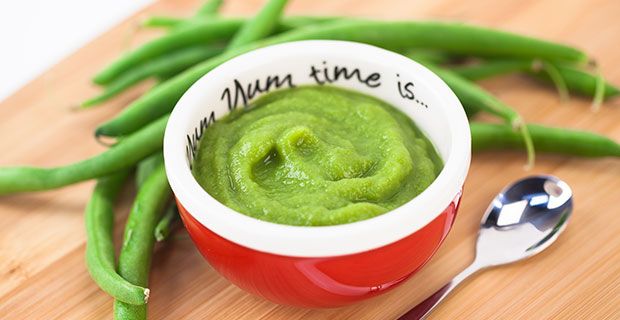 It is cauliflower and broccoli that are often referred to as "higher education cabbage" because they are rich in vitamins and minerals.
It is cauliflower and broccoli that are often referred to as "higher education cabbage" because they are rich in vitamins and minerals.
Vegetables to expand the diet
If complementary foods are introduced at the age of 4-4.5 months , then the first vegetables can be monocomponent, homogenized purees: zucchini, cauliflower, broccoli, potatoes, carrots.
At the age of 5 months of a child's life and older, the assortment is expanded by vegetable puree from pumpkin, beetroot, white cabbage.
At the age of 6 months and older, the addition of tomatoes is possible.
At the age of 7 months it is possible to expand the vegetable diet by adding green peas.
Vegetable purees of industrial production for the first feeding can be of various degrees of grinding:
- homogenized (strongly crushed, the number of pulp particles 0.
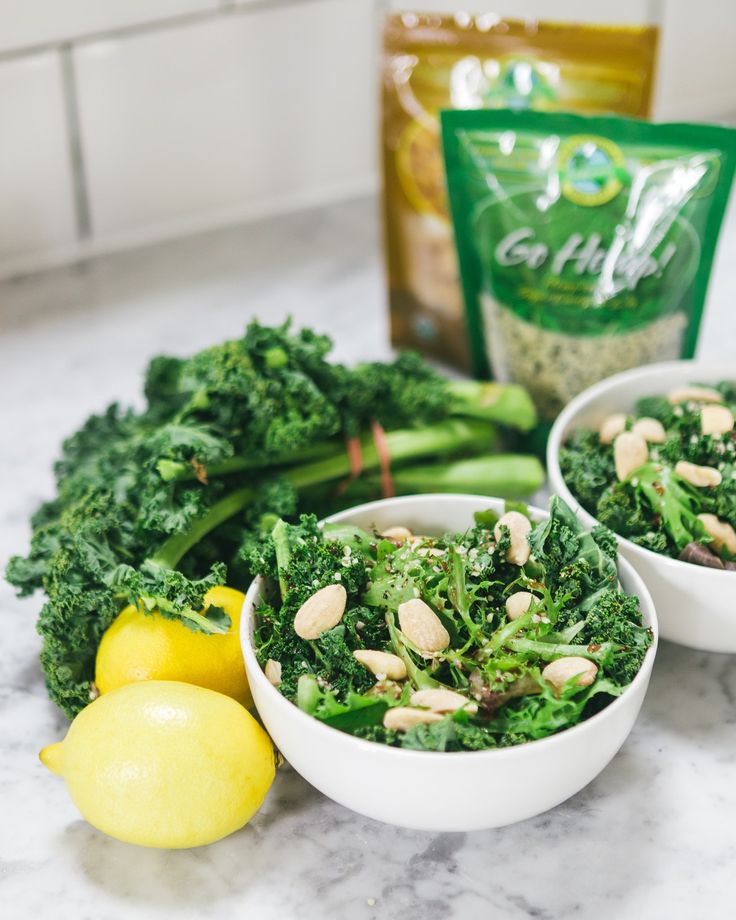 15-0.3 mm in size) - for children older than 4 months of life;
15-0.3 mm in size) - for children older than 4 months of life; - pureed (particle size no more than 0.4 mm) and coarsely ground (particle size 2 - 5 mm) - for children over 6 months of age.
Complementary foods from vegetables should be semi-liquid, well-mashed, homogeneous, the transition to thicker foods should be gradual, accustoming the child to chewing with age.
How to introduce vegetable complementary foods (vegetable puree schedule)
Zucchini, cauliflower and broccoli are hypoallergenic foods and are the best for starting the first complementary foods. One-component vegetable puree is given to a child with a teaspoon, preferably in the morning for breakfast. It is NOT necessary to salt or sweeten vegetable purees for a child.
Vegetable puree schedule :
On the first day , the baby is given ½ teaspoon of vegetable puree (such as squash) and then the baby is supplemented with normal food (breast milk or a bottle of formula). During the day, monitor the body's reaction to the introduced product - carefully examine the skin for rashes, pay attention to the stool, if there is mucus and greenery in the feces.
During the day, monitor the body's reaction to the introduced product - carefully examine the skin for rashes, pay attention to the stool, if there is mucus and greenery in the feces.
On the second day , if there are no signs of allergy or problems with the tummy, the child is given 1-2 teaspoons of marrow (5-10 g) and supplemented with formula or milk.
On the third day - 3 teaspoons (15 g).
For the fourth - 4-5 teaspoons. (20-25 years).
On the fifth day - 50 g. If there is no negative reaction to the introduced product, then the portion can be doubled.
On the sixth day - 80-100 g., you can give the child a portion twice the previous one.
On the seventh day - 120-150 g., which completely replaces one feeding. The norm in grams per feeding is indicated for a six-month-old child, if complementary foods were introduced earlier, then the amount of the product should be reduced. If your child is breastfed, then after taking vegetable puree, be sure to breastfeed your baby, even if the volume of complementary foods completely replaces the whole feeding, so you can maintain lactation for a longer time.
If your child is breastfed, then after taking vegetable puree, be sure to breastfeed your baby, even if the volume of complementary foods completely replaces the whole feeding, so you can maintain lactation for a longer time.
For another week, the child is allowed to get used to vegetable marrow puree, and only after 5-7 days is a new vegetable introduced into the diet, such as broccoli. This rule is important to observe if complementary foods are introduced to a child at the age of 4-4.5 months.
Eighth day - ½ teaspoon of broccoli, then we feed the zucchini puree.
Ninth day - 1-2 teaspoons of broccoli (5-10 g) and give zucchini up to the age dose, etc. Gradually, the amount of broccoli is replacing the first vegetable for feeding - zucchini.
If the child refuses mashed vegetables, take a break for a few days and offer the child mashed potatoes again or replace the vegetable - for example, zucchini with cabbage.
Which is better - buy or prepare vegetable puree for feeding yourself
Articles on the topic
Complementary foods: basic rules and administration schemes
Feeding with cereals
at the stove: cook, grind, it is better to devote this time to the child.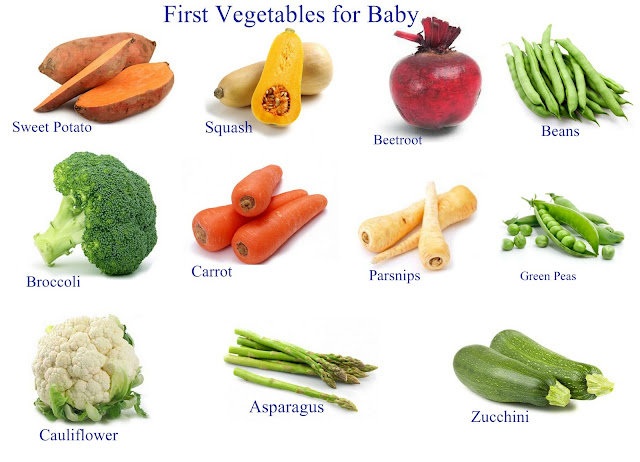 Also, canned vegetable puree is convenient to take on the road. Canned baby food is recommended for use by leading global and domestic health organizations, so the choice of parents depends only on their preferences and financial capabilities.
Also, canned vegetable puree is convenient to take on the road. Canned baby food is recommended for use by leading global and domestic health organizations, so the choice of parents depends only on their preferences and financial capabilities.
If you plan to purchase factory-made vegetable puree, then carefully read the ingredients. In addition to vegetables and water, there should be nothing in the jar - no preservatives, dyes, flavors and flavor enhancers, including starch as a thickener. It is desirable that vegetable puree for complementary foods does not even contain salt and sugar, has a uniform structure and natural color.
Store-bought puree in jars should be heated in a water bath before being given to a child. Before you give puree to your baby, be sure to try it yourself. If you feel signs of spoilage of the product, such as a pungent odor, a sour taste, or when you open the jar you do not hear a characteristic pop, then the tightness of the jar has been broken and such a jar should be discarded. However, an adult may simply not like the taste of baby vegetable puree, due to the lack of additives such as sugar and salt, but this does not mean that it is not suitable for complementary foods. The started jar should be stored only in the refrigerator and no more than a day.
However, an adult may simply not like the taste of baby vegetable puree, due to the lack of additives such as sugar and salt, but this does not mean that it is not suitable for complementary foods. The started jar should be stored only in the refrigerator and no more than a day.
If the parents have limited funds or eat their own vegetables from the garden or household plot (imported vegetables often contain nitrates), then the mother will be able to prepare vegetable puree for complementary foods on her own. If you don’t have your own garden, then when buying, pay attention to the country of origin, and choose, if possible, vegetables grown in your area. When choosing vegetables for feeding, pay attention to their appearance: they should not have defects (black dots, brown spots, dry or wrinkled skins, dents, etc.), but they should not look large and with a glossy sheen (such vegetables, most likely subjected to strong chemical treatment). If the introduction of complementary foods with vegetables falls on the “off season”, when there are no fresh vegetables or there are only imported ones, pre-made frozen preparations are perfect.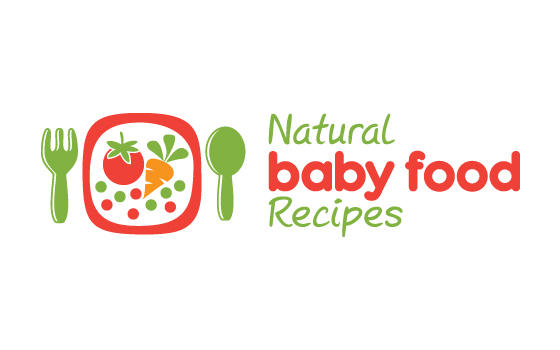 Just remember that vegetables should not be thawed before cooking, since most of the vitamins are destroyed during the process of slow defrosting.
Just remember that vegetables should not be thawed before cooking, since most of the vitamins are destroyed during the process of slow defrosting.
For self-preparation of vegetable puree, it is advisable to purchase a steamer and a blender. Before cooking, vegetables must be thoroughly washed and peeled, since most of the harmful substances are contained in the peel. Remove all the top leaves from the cabbage and remove the stalk from it. And cut off the big “tail” of carrots and beets.
Take one type of vegetable, such as zucchini, wash, peel, cut and cook in a double boiler or in an enamel saucepan with a little water. To save more nutrients, boil the vegetables whole or cut them into large pieces. Vegetables should only be placed in boiling water, and cooked with the lid closed, but the best option for baby food is steaming vegetables.
Then transfer the vegetables to a blender, if necessary, add a little boiled water (so that the puree is not too thick). Vegetables for the first feeding should be completely boiled, without lumps.